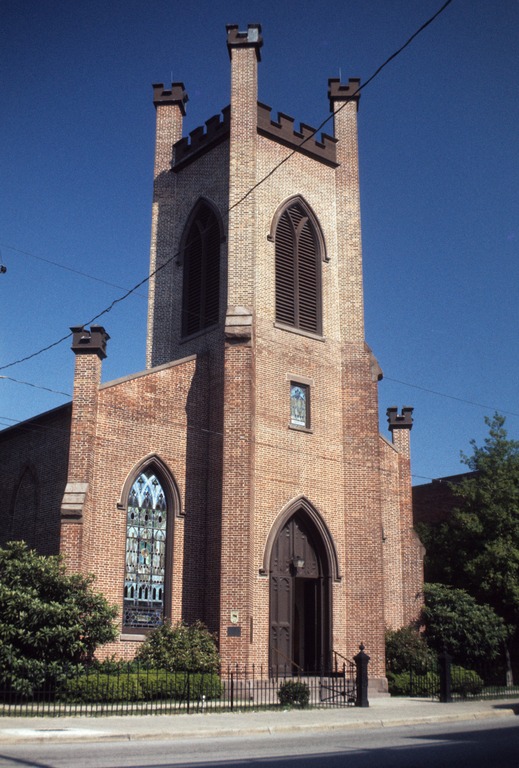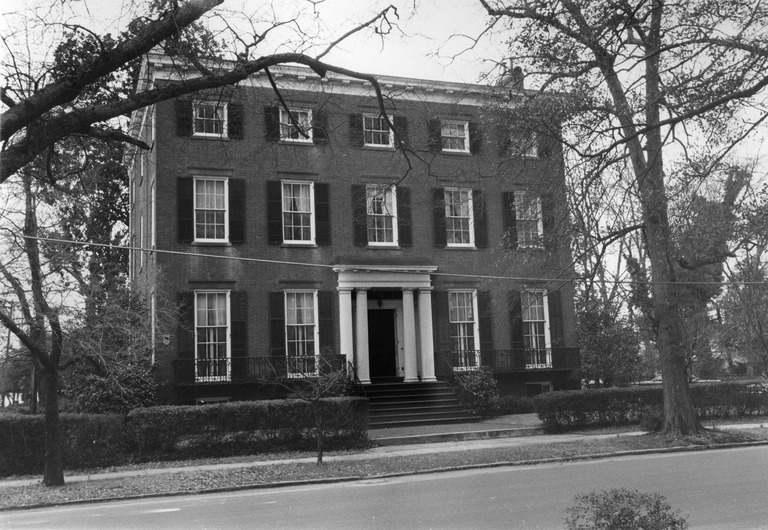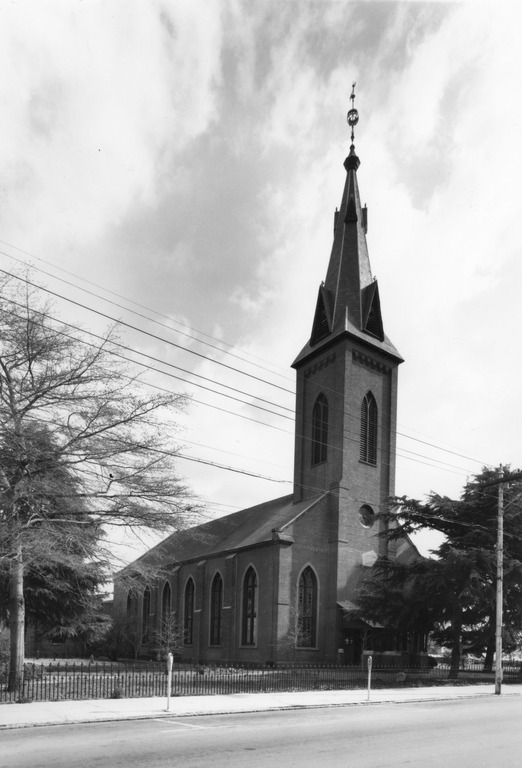Lane, Hardy B., Sr. (1793-1856)
Birthplace:
New Bern, North Carolina, USA
Residences:
- New Bern, North Carolina
Trades:
- Builder
- Carpenter/Joiner
NC Work Locations:
Building Types:
Styles & Forms:
Gothic Revival; Greek Revival
Hardy B. Lane, Sr. (1793-1856), New Bern’s leading house carpenter during the late antebellum period, worked on most of the city’s premier buildings of the period and is associated by tradition with others. He also trained three of his sons in his trade, who continued as prominent builders in the city, including Frederick Lane (ca. 1824-1868), Hardy B. Lane, Jr. (b. ca. 1829), and John B. Lane (1834-1910), who worked on their own and as the Lane Brothers in the later 19th century.
Hardy B. Lane, Sr., exemplifies the successful local builder who spent his entire career in a single community—a contrast to the many artisans of his era who moved from place to place. He generally referred to himself as a “carpenter and builder,” but occasionally identified himself as the “architect” of a given building. He was a son of Frederick Lane, also a New Bern carpenter, who died when Hardy was a minor, leaving an estate that included seven slaves and a large collection of carpenter’s tools. Frederick Lane may have been the man named Frederick Totevine, son of Mary Totevine, who changed his name to Frederick Lane in 1784. Hardy B. Lane married Harriet Benson (Banson?) of New York in 1818, and the couple had four sons. In 1825 Lane took a free black apprentice, Frederick Merrick, aged 14, to the carpenter’s trade, and in 1834 he apprenticed white orphan Alonzo Willis, aged 15, who became a successful local builder and manufacturer.
Lane was born and came of age during a period when New Bern was the largest town in the state, when the demand for construction was high, and when its builders were constructing elegant architecture in the Federal style. But by the mid-1820s, the city’s economy was slowing, and during the 1830s, there was little growth or construction. New Bern was surpassed in size by Wilmington and Fayetteville. Indeed, in 1839, when David Paton, architect of the North Carolina State Capitol, wrote to Lane hoping to recruit “eight first rate Joiner’s” to help on that project, Lane responded, “I do not believe their [sic] could be one procured from this place that would answer the purpose desired.” In the mid-1840s, however, as the naval stores business and other trade revived, new building projects began, and Lane was poised to undertake them. Like other builders, he sometimes erected buildings from his own designs or adapted from architectural books, and sometimes executed designs by out of town architects. And, as was typical, in some cases he took on the carpentry component of a brick building; in other cases he contracted for the whole project.
As a leading carpenter, Lane undertook woodwork and carpentry on several key churches. An early and important project was the carpentry work for the Christ Episcopal Church (1821-1824), an unusually early example of the Gothic Revival style, built of brick laid in Flemish bond. The project involved several of New Bern’s most prominent builders, “architects” Martin Stevenson and Thomas S. Gooding, and bricklayers Bennett Flanner and Wallace Moore. In 1832 Lane was one of a committee to inspect repairs on the church, including installation of iron tie rods.
In 1840 the town’s small Catholic congregation sought to build a church. Initially, as documented by church historian Stephen C. Worsley, their leaders including distinguished jurist William Gaston considered an imposing Gothic Revival design by New York architect Alexander Jackson Davis. But when this proved too costly, a simpler design was selected. Lane, chosen as builder for the $3,784.34 contract, participated in planning the “handsome plain frame building of ordinary materials.” Following a simple meetinghouse plan, St. Paul’s Catholic Church (1840-1841) features Greek Revival corner pilasters; the entrance tower was added in 1896.
Lane also undertook the carpentry and woodwork for the more ambitious First Baptist Church (1845-1848) in New Bern. The Gothic Revival church of Flemish bond brickwork with central entrance tower was based on a design obtained from New York architects T. Thomas and Son; it was among the first instances in the state of a Gothic Revival church built for a congregation that was not Episcopalian or Catholic.
An especially important project for Lane was the construction of the Griffin Free School, supported by a bequest from Moses Griffin. In a deposition about the building, Lane identified himself as its “architect.” The 2-story, Greek Revival building, set on a raised basement, measured 55 by 45 feet and cost $11,000. As described by Lane in detail (see Sandbeck, Historic Architecture of New Bern and Craven County), it was constructed of common brick and “hard Baltimore face Brick,” with sills and lintels of brownstone, and roofed with tin. The full extent of Lane’s work in New Bern is unknown. But as one of the town’s leading antebellum builders, as evidenced by his involvement in key public projects, doubtless he was involved in many of the city’s substantial residences of the period.
In The Historic Architecture of New Bern and Craven County,Sandbeck attributes several Greek Revival style residences to Lane based on similarities to his documented works. Prime among these is the Charles Slover House (1848-1849), which strongly resembles the Griffin Free School. Other likely attributions, with similar woodwork elements of bold Greek Revival character, include the Dixon-Stevenson House, William Hollister House, Edward F. Smallwood House, Edward R. Stanly House, John D. Flanner House, and Hughes-Jones House. Documentation for these may yet come to light.
Like many antebellum builders, Lane depended on slave workers as well as free men. The 1850 U.S. census listed the 59-year-old “house joiner” as having eighteen slaves in his household, some of whom he may have hired from other owners. At his death in 1856, Lane owned thirteen slaves, including carpenters Bill (aged 30), Mingo (aged 28), and Donum (aged 26). Lane also relied on family members in his trade. The 1850 census showed that his two younger sons Hardy (aged 21) and John (aged 13) were working in his household, while the eldest son, Frederick (aged 26), also a house joiner, headed a household next door. Such continuity was not uncommon among artisan families of the period. The Lane family enjoyed a life of some gentility, as evidenced by such possessions as mahogany furniture, carpets, books, and “mantel ornaments.”
Hardy B. Lane, Sr., favored technological modernization, especially railroad development. He was one of the commissioners who formed the capital stock of the Atlantic and North Carolina Railroad in New Bern in 1854. That line connected New Bern to the North Carolina Railroad and thus with points west and north. It also brought to the port town a large railroad repair shop and foundry, all of which boosted the economy in the late 1850s. After the elder Lane’s death in 1856, his three sons—known as the Lane Brothers—continued in the building trade in New Bern, participating in its renewal after the Civil War and working in popular Victorian-era styles.
- Catherine W. Bishir, Lynda V. Herzog, and Peter B. Sandbeck, “North Carolina Architects and Builders: Hardy B. Lane and Sons,” North Carolina Preservation, 64 (July-Aug. 1986).
- Catherine W. Bishir, North Carolina Architecture (1990).
- Catherine W. Bishir and Michael T. Southern, A Guide to the Historic Architecture of Eastern North Carolina (1996).
- Gertrude S. Carraway, Crown of Life: History of Christ Church, New Bern, N. C., 1715-1940 (1940).
- Craven County Records, North Carolina State Archives, Raleigh, North Carolina.
- Lynda Vestal Herzog, “The Early Architecture of New Bern, 1750-1850,” Ph.D. dissertation, University of California (1977).
- Peter B. Sandbeck, The Historic Architecture of New Bern and Craven County, North Carolina (1988).
- Stephen C. Worsley, “Catholicism in Antebellum North Carolina,” North Carolina Historical Review, 60.4 (Oct. 1983).
Charles Slover House
Contributors:Hardy B. Lane, Sr., attributed carpenterVariant Name(s):Charles Slover House and Dependencies
Dates:1848-1849
Location:New Bern, Craven CountyStreet Address:201 Johnson St., New Bern, NC
Status:Standing
Type:Residential
Images Published In:Catherine W. Bishir and Michael T. Southern, A Guide to the Historic Architecture of Eastern North Carolina (1996).
Peter B. Sandbeck, The Historic Architecture of New Bern and Craven County, North Carolina (1988).Note:The 3-story house of Flemish bond brickwork, accented by brownstone trim, is the most imposing Greek Revival residence surviving in New Bern. It is attributed to carpenter-builder Hardy B. Lane based on similarities with other work in town—especially his documented Griffin Free School. The brickmason for the fine brickwork remains unidentified. It is likely that many other antebellum buildings with similar woodwork were Lane’s as well.
Christ Episcopal Church
Contributors:George Bishop, contractor (1871-1885); Bennett Flanner, brickmason (1821-1824); Thomas S. Gooding, builder and architect (1821-1824); Hardy B. Lane, Sr., carpenter/joiner (1821-1824); Wallace Moore, brickmason (1821-1824); Martin Stevenson, builder and architect (1821-1824)Dates:1821-1824; 1871-1885 [rebuilt]
Location:New Bern, Craven CountyStreet Address:320 Pollock St., New Bern, NC
Status:Standing
Type:Religious
Images Published In:Catherine W. Bishir, North Carolina Architecture (1990).
Catherine W. Bishir and Michael T. Southern, A Guide to the Historic Architecture of Eastern North Carolina (1996).
Peter B. Sandbeck, The Historic Architecture of New Bern and Craven County, North Carolina (1988).Note:Christ Episcopal Church in New Bern, built in 1821-1824, was one of the first Gothic Revival churches in North Carolina. Although the local newspaper cited Martin Stevenson and Thomas S. Gooding, local artisans, as “architects,” in 1820 the parish already had a plan for a church to be 70 by 55 feet, of brick, and with “high arched windows” before letting the contract. It was built of Flemish bond brickwork with pointed arched windows and a blending of Gothic Revival, Federal, and Greek Revival details. It is tempting to attribute some role in design to architect William Nichols, who had been in New Bern earlier, but there is no documentation of his role. Only the walls of this first period survive: after a fire in 1871 the church was rebuilt by George Bishop using the old walls. The image here shows the church after it was rebuilt following the fire. See Sandbeck, New Bern, and Bishir, North Carolina Architecture, for drawings of the 1820s church before the fire.
First Baptist Church
Contributors:Hardy B. Lane, Sr., carpenter; T. Thomas and Son, architectsDates:1845-1848
Location:New Bern, Craven CountyStreet Address:239 Middle St., New Bern, NC
Status:Standing
Type:Religious
Images Published In:Catherine W. Bishir, North Carolina Architecture (1990).
Catherine W. Bishir and Michael T. Southern, A Guide to the Historic Architecture of Eastern North Carolina (1996).
Peter B. Sandbeck, The Historic Architecture of New Bern and Craven County, North Carolina (1988).Note:Lane was the carpenter for the Gothic Revival church, one of the first non-Episcopal churches in the Gothic Revival style in the state; it was built from a design, local tradition states, by the architectural firm of T. Thomas and Son. The church follows a popular, symmetrical form with central entrance tower seen earlier at Wilmington’s St. James Episcopal Church (Thomas U. Walter) and others. It is of brick laid in Flemish bond and, like other New Bern brick buildings of its era, it is trimmed in brownstone. The church has been altered and gained many additions over the years, but the external character of the antebellum church remains.The brickmason has not been identified.
Griffin Free School
Contributors:Hardy B. Lane, Sr., builder and architectDates:1849-1851
Location:New Bern, Craven CountyStreet Address:George St., between Main St. and Cypress St., New Bern, NC
Status:No longer standing
Type:Educational
Images Published In:Peter B. Sandbeck, The Historic Architecture of New Bern and Craven County, North Carolina (1988).
Note:Records of the school give a detailed account of its construction and the role of Hardy B. Lane, Sr., as builder and “architect” of the 2-story, brick, Greek Revival building. See Moses Griffin Estates Papers, Craven County Records, North Carolina State Archives, Raleigh, North Carolina. The brickmason has not been identified.
J.A. Jones Residence
Contributors:Hardy B. Lane, Sr., builder (1851-1853); Herbert W. Simpson, architect (ca. 1905)Variant Name(s):Hughes-Jones House
Dates:1851-1853; ca. 1905 [remodeled]
Location:New Bern, Craven CountyStreet Address:500 block, N side of Broad St., New Bern, NC
Status:No longer standing
Type:Residential
Images Published In:Peter B. Sandbeck, The Historic Architecture of New Bern and Craven County, North Carolina (1988).
Note:The brick house (pictured by Sandbeck) was built in castellated Gothic Revival style by Hardy B. Lane, Sr. for Isaac Hughes, one of New Bern’s richest men in the 1850s. In one of the city’s most thorough-going residential remodelings, Herbert Simpson redesigned it as a Colonial Revival residence with tall classical portico. It was demolished in the mid-20th century.
Moses Griffin School
Contributors:William H. Jones, brickmason; Hardy B. Lane, Sr., carpenter and contractor; Isaac C. Rue, bricklayer and plastererDates:1848-1851
Location:New Bern, Craven CountyStreet Address:George St., New Bern, NC
Status:No longer standing
Type:Educational
Images Published In:Catherine W. Bishir, Crafting Lives: African American Artisans in New Bern, North Carolina, 1770-1900 (2013).
Peter B. Sandbeck, The Historic Architecture of New Bern and Craven County, North Carolina (1988).Note:The wealthy New Bernian Moses Griffin left a bequest to build a school, and his estates papers and other records document the costs and the workmen involved. House carpenter Hardy B. Lane was the principal “architect” and builder, and William [H.] Jones was the principal white bricklayer. Much of the work was accomplished by free and enslaved artisans of color including Richard Tucker and Isaac C. Rue. It was a substantial Greek Revival style brick building similar in detail to other local buildings of the late antebellum period. It burned in 1922. See Sandbeck, New Bern, and Bishir, Crafting Lives.
St. Paul's Catholic Church
Contributors:Hardy B. Lane, Sr., carpenterDates:1840-1841
Location:New Bern, Craven CountyStreet Address:504 Middle St., New Bern, NC
Status:Standing
Type:Religious
Images Published In:Catherine W. Bishir and Michael T. Southern, A Guide to the Historic Architecture of Eastern North Carolina (1996).
Peter B. Sandbeck, The Historic Architecture of New Bern and Craven County, North Carolina (1988).Note:The contract with Hardy B. Lane, Sr. for the frame church survives in church records.



